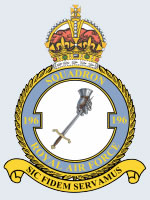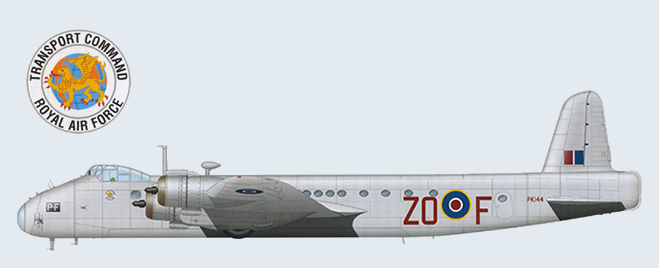
Squadron Badge: A Mailed Fist holding a Dagger, hilt downwards
Motto: ‘Sic fidem servamus’ (‘Thus we keep Faith’)
Note: The Badge refers to some of the squadrons wartime functions, the mailed fist indicating the power of its bombing and the dagger being handed down from the sky its supply dropping activities.
HISTORY
No.196 Squadron was formed, on 09 August 1917 at Heliopolis, Egypt as a training unit. It disbanded 3 months later, on 13 November 1917 becoming part of the Aerial Flying School.
Squadron Code Letters ‘ZO’, ‘5T’ & ‘7T’.
No.196 Squadron reformed at Driffield, on 07 November 1942, as a Night Bomber Squadron in No.4 Group Bomber Command, and during the period February-October 1943 made many raids on enemy ports and industrial centres in Europe (the very first No.196 Squadron’s operational mission was a raid to bomb Lorient in the night of 04/05 February 1943) but No.196 Squadron also carried out ‘Gardening’ (minelaying) operations.
It flew Wellingtons Mk III & Mk X with No.4 Group at first and then moved to Witchford on 19 July 1943, flying Stirlings Mk III with No.3 Group Bomber Command where No.196 Squadron had been transferred (also on 19 July 1943).
On 18 November 1943 following its move to Leicester East, No.196 Squadron was transferred to No.38 Group, Allied Expeditionary Air Force (AEAF). No. 196 Squadron had flown its last operational mission with Bomber Command in the night of 10/11 November 1943.
Now and during the remainder of the European war, No.196 Squadron would carry out ‘cloak and dagger’ operations: Transport, glider towing operations and supply-dropping to resistance forces (it also comprised drops of parachutists, SOE and SAS missions over occupied territories: Operating alone and at very low level ; ”Each full moon period was the time for SOE and SAS operations. These were highly secret[…]at 200ft or 300ft almost always in moonlight over the DZ…” as a No.38 Group Veteran explained).
First of all, No.196 had to convert to the Stirling Mk IV, the version of the famous aircraft devoted to the ‘cloak and dagger’ operations but with only one rear turret to defend, instead of 3 turrets before…
On 07 January 1944, No.196 Squadron moved to Tarrant Rushton and, began Mk IV operations in the night of 03/04 February 1944 when EF469 and EJ110 flew night supply drops to the French Resistance. The conditions of these operations were dangerous and sadly, EJ110 (P/O Pryke, 04 February) & EF469 (F/O Moore, 05 February) failed to return from France.
But ‘cloak and dagger’ operations were vitals and many were flown on succeeding flights until the end of the war.
No.196 Squadron moved to Keevil on 14 March 1944 (this month No.196 flew 14 SOE sorties).
SOE flights didn’t stop at Keevil but No.196 had also to train and, so with other No.38 Group Squadrons, made massed glider-towing training flights (they were very spectacular and dangerous exercises and so unfortunately accidents could arrive) and, at the end of May, No.38 Group Squadrons were at peak readiness for Operation ‘OVERLORD’.
No.196 Squadron was based at Keevil with an other No.38 Group Squadron: No.299. These 2 Squadrons had the same details planned for ‘D’-Day:
They would carry paratroops of 5th Paratroops Brigade, 6th Airborne Division, in Phase II of Operation ‘TONGA’ (with each Stirling carrying 20 troops and their equipment).
At 23:00 hrs the engines of the 46 Stirlings (23 from No. 196 Squadron) of No.196 and No.299 Squadrons burst into life. The first rolled at 23:19 hrs and the Stirlings took off at half-minute intervals leaded by No.196 Squadron’s aircraft.
After having been dropped on DZ ‘N’, paratroops’ task was to hold bridges crossing the River Orne and the Caen Canal. All the No.196 Squadron’s crews made their task but several aircraft suffered flak damage and some airmen were injured. Sadly, a No.196 Squadron’s Stirling, LJ841 of F/L Gribble, failed to return from France.
Later on 06 June, aircraft were prepared again and shortly after 18:00 hrs, No.196 and No.299 Squadrons’ Stirlings took off again, this time for Operation ‘MALLARD’. 17 gliders were towed by No.196 Squadron during this operation. The task was to deliver the Horsa gliders to DZ ‘W’ to reinforce paratroops dropped to seize the Orne and Caen Canal bridges. All the No.196 Squadron’s Stirlings returned to base.
No.196 Squadron flew a last mission for Operation ‘OVERLORD’ on 08 June 1944, Operation ‘ROB ROY’, the re-supply of the allied forces engaged in the Invasion of Europe (No.196 provided 7 Stirlings and all returned safe to Keevil).
As other No.38 Group Squadrons, following ‘OVERLORD’, No.196 returned to the ‘cloak and dagger’ operations, which were always so hazardous, until 11 September because the squadron had to prepare for the next major airborne operation: ‘Arnhem’. (See a few example of ‘cloak and dagger’ operations in: Jedburghs (SOE) and SAS in Brittany, France).
From 17 to 23 September 1944, Operations ‘MARKET’:
Sunday 17 September 1944, ‘MARKET I’. 25 No.196 Squadron’s Stirlings towed gliders to capture 3 important bridges at Grave, Nijmigen and Arnhem. Only 21 succeeded but the 25 aircraft returned safe.
‘MARKET II’, 18 September. This time No.196 Squadron towed 22 Horsa gliders (3 were unsuccessful) but all Stirlings again returned safe despite of AA guns deployed.
‘MARKET III’, 19 September. 25 Stirlings took off to re-supply troops. Many Stirlings returned with several flak damages, and sadly a first No.196 Stirling failed to return (EF248 of W/O Prowd).
‘MARKET IV’, 20 September. 17 Stirlings took off again for re-supply but 20 September 1944 was to be a very sad day for No.196 Squadron because 7 aircraft never returned: Flak was more and more intense and frightful but with great courage and despite the fact that numerous crews (while they were circling to wait for their turn to drop) saw many of their friends flying before them falling in flame, they made very low drops for more precise accuracy (fortunately most of the No.196 Squadron’s airmen survived the crashes).
‘MARKET V’, 21 September. Only 10 aircraft could take off to re-supply troops engaged in Holland. This time again flak was terrifying but there were also now German fighters and so 3 other No.196’s aircraft failed to return (LJ810 of W/O Azouz DFC, LJ843 of F/S Green and LJ928 of F/S Waltrich).
‘MARKET VII’, 23 & 24 September (‘MARKET VI’ had been cancelled because the weather was too poor). On 23rd, 13 aircraft took off for a more re-supply operation of troops. One aircraft, LJ949, was flak damaged and didn’t return. The drop of LJ949 had been successful but the Pilot, F/O Sparks, and the Wireless Operator/Air Gunner, F/S Herring, were injured by flak so the plane had to make a safe crash land at Leende.
Finally, on 24th, 3 aircraft took off but couldn’t succeed in their re-supply drop. F/S Draper’s Stirling IV LK142 was damaged and couldn’t return to base so he had to crash land in France.
With 115 Sorties, No.196 Squadron was the 38 Group Squadron who flown the most sorties for Operations ‘MARKET’, 25 men were killed and 13 aircraft were lost due to heavy anti-aircraft fire and enemy planes (No.196 & 620 Squadrons each lost 13 aircraft and were the two No.38 Group Squadrons who lost the most aircraft during Operations MARKET).
As soon as this major airborne operation was finished, No.196 Squadron rebuilt his strength of Stirlings to be ready for other operations. All the No.38 Group Squadrons were redeployed and on 09 October 1944, No.196, and also No.299 Squadron, went to a new base, Wethersfield.
‘Cloak and dagger’ dangerous operations continued.
In February 1945, No.196 Squadron began tactical bombing raids in support of the Army and on 21 February, Wing Commander Baker, Commanding Officer of No.196 Squadron, failed to return.
But No.196 Squadron also had already begun to prepare the next major airborne operation: ‘VARSITY’ since November 1944.
For the ‘Rhine’ crossing on 24 March 1945 – Operation ‘VARSITY’, 30 No.196 Squadron’s Stirling towed gliders from Shepherds Grove, the new No.196’s station since 26 January 1945. It was the maximum of Stirlings that No.196 could provide (89 troops plus many vehicles were carried). Only one of the 30 Stirling was touched by flack (LJ979 of F/L Van Rennan). This aircraft made a safely crash-land in Holland. A member of the crew was badly wounded but happily he survived. Back at Shepherds Grove, the 29 Stirlings were nearly all undamaged.
As soon as ‘VARSITY’ was over, ‘cloak and dagger’ missions were flown mainly over Scandinavia until the end of April 1945. No.196 also ferried mail, supplies and petrol for Allied forces.
In May 1945 troops were taken to Denmark & Norway (Operations ‘SCHNAPPS’ and ‘DOOMSDAY’ respectively) to disarm the German forces there (the weather was dreadful and one aircraft didn’t return, LK147 of Flying Officer Breed).
After ‘VE’-Day, No.196 Squadron was employed on transport support with Transport Command, and undertook ‘Trooping’, ‘Freighting’, and ‘Mail-Carrying’ before being finally disbanded on 16 March 1946.
Link to the 196 Squadron information on the International Bomber Command Centre website:
Browse Items · IBCC Digital Archive (lincoln.ac.uk)
(Thanks to Steven White)

Commanding Officers
November 1942 Wing Commander R.H. WATERHOUSE CBE, DFC, AFC, MiD, S S(US)
S S(US): Silver Star – United States of America
March 1943 Wing Commander A.G. DUGUID
June 1943 Wing Commander N. ALEXANDER DFC
August 1944 Wing Commander M.W.L.L.V. BAKER MiD (KiA, 21 February 1945)
February 1945 Wing Commander R.T.F. TURNER DFC, MC, DFC(US)
08 January 1946 Wing Commander J. BLACKBURN DSO & Bar, DFC & Bar, DFC(US)
(W/C Blackburn completed the record of 5 tours of operational duty during WWII)

Date / Base / Aircraft
07 November 1942 Squadron Formed at Driffield Yorkshire in No.4 Group Bomber Command
22 December 1942 / Leconfield Yorkshire
December 1942 / Leconfield Yorkshire / Wellington III, Wellington X
January 1943 / Leconfield Yorkshire / Wellington X
19 July 1943 / Witchford Cambridgeshire Transferred to No.3 Group Bomber Command
July 1943 / Witchford Cambridgeshire / Stirling III
18 November 1943 / Leicester East Leicestershire / Stirling III Transferred to No.38 Group

No.196 Squadron
Shepherds Grove, start of 1946
07 January 1944 / Tarrant Rushton Dorset / Stirling III
January 1944 / Tarrant Rushton Dorset / Stirling IV
14 March 1944 / Keevil Whiltshire / Stirling IV
09 October 1944 / Wethersfield Essex / Stirling IV
26 January 1945 / Shepherds Grove Suffolk / Stirling IV
January 1946 / Shepherds Grove Suffolk / Stirling IV, Stirling V
16 March 1946 Squadron Disbanded
Next page: 295 Squadron

